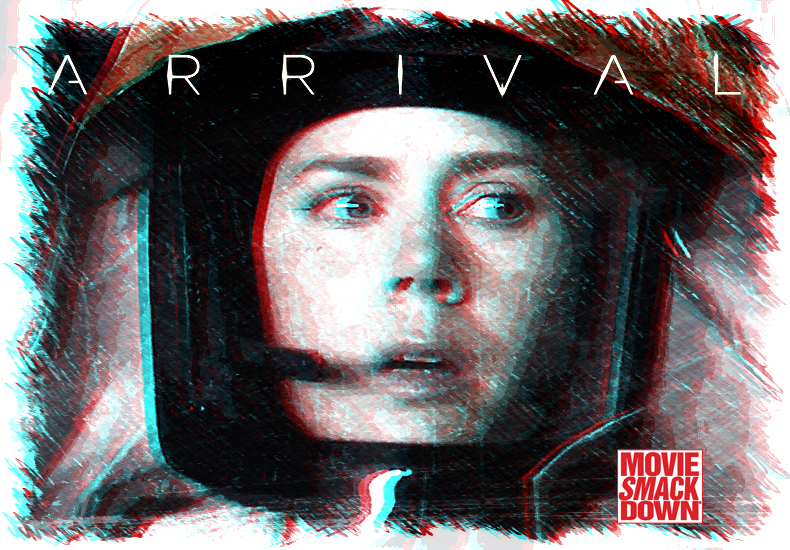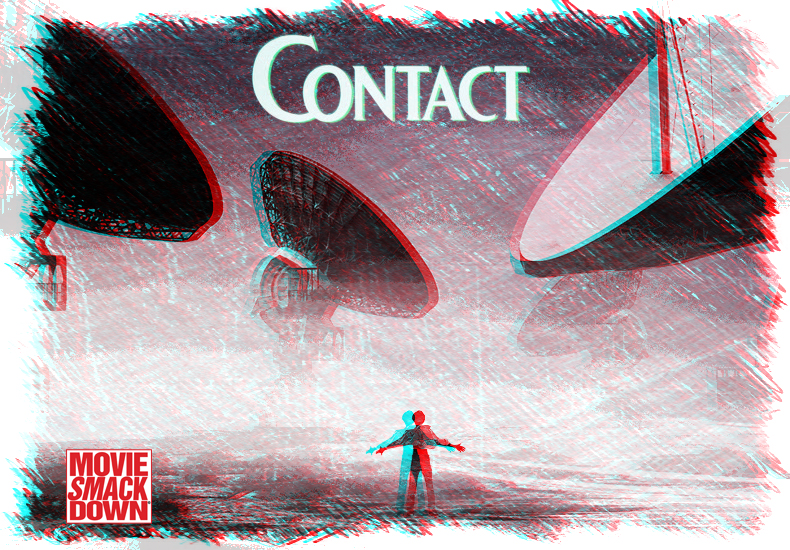![Bryce Zabel @ The Smack www.moviesmackdown.com]() The Smackdown
The Smackdown
Arrival is a big, fat Smackdown target, given the boxes it checks from other classics. Aliens arrive in massive ships all over the world like they do in Independence Day. It has a brainy female scientist who is desperately needed so that clueless authorities can understand how aliens talk, as in Contact. It’s got Interstellar’s shifting reality and its spacey interpretation of the parent/child relationship. It also comes complete with a mother grieving a lost child, as in Gravity. It even has the U.S. government setting up in remote places to talk to these giant alien hovercraft like they did in Close Encounters of the Third Kind.
That would be check, check, check, check and check. Which is another way of saying that Arrival clearly has arrived with ambition to stand among some very powerful, important films even if there is a bit of Frankenstein-type borrowing stitched into its fabric.
Try this for a logline: A brilliant woman interested in communication is chosen to lead a global response to extraterrestrial contact and is changed forever by the experience.
Yes, that’s the high concept behind Arrival, coming soon to a theater near you. But it’s also the idea behind Contact. That’s why they go into the ring together for this one.

The Challenger
Since we’ve already laid out what Arrival is, here’s what it isn’t. It’s not a big alien invasion blockbuster, despite what its YouTube trailers might lead you to believe. You actually are going to have to think about this one in order to penetrate its world fully.
The film began as a short story, “Story of Your Life” by Ted Chiang, got turned into a screenplay by Eric Heisserer, and ended up on the big screen under the direction of Denis Villeneuve. Together they’ve turned out something that explores some fascinating ideas, with a look that is beautiful and at times challenging. Oh, and it’s got a Rod Serling twist.
Amy Adams plays college linguistics professor Dr. Louise Banks, and when me meet her she is sad and just going through the motions. Through flashbacks, we see that Louise had a daughter who died of cancer. The girl’s father is a scientist, we learn, but he’s not around these days.
When extraterrestrials show up, we just know that A) Amy is going to be needed, and B) her emotional tragedy over her child will have to be a part of this film.
Amy gets drafted by the military to travel to one of 12 alien ships, this one hovering over Montana. Her job is to work with Forest Whitaker’s Colonel Weber and a physicist played by Jeremy Renner. We know that Amy and Jeremy’s characters are super-smart because she acts with very little make-up and he wears glasses.
These people try to get the aliens to fess up on some basic questions. What is their purpose here on Earth? Where are they from? And if Donald Trump wanted to build a wall to keep them out, who would pay for it?
The Defending Champion
Contact, the film directed by Robert Zemeckis, is a far more faithful adaption of Contact, the novel written by Carl Sagan, than most book-to-movie adaptations can claim. Sometimes that’s a good thing, sometimes not, but in this case, it means the story is set on tested and solid ground.
This is a sprawling canvas set before us, and the film’s reputation has grown over the years.
In both the book and the film, radio astronomer Dr. Ellie Arroway (Jodie Foster in the film) hits the cosmic jackpot when the giant radio telescopes that are part of S.E.T.I. (Search for Extra-terrestrial Intelligence) actually turn up a non-random signal from across the universe. Someone is talking to us or, more accurately, talking back. You see, they’ve picked up the very first television transmission the Earth ever leaked outward, amped it up and sent it back to us.
It’s an excellent surprise and — without spoiling it — let’s just say that the first TV signal that went out from Earth is, well, unexpected. It kicks the film into territory where no movie has really gone before.
The characters, however, often feel stock. The hero must be impeded by standard blocking devices, in this case, White House advisers played by James Woods and Angela Bassett, and Tom Skerritt, whose character steals credit for all Ellie’s work. There is also the non-standard religious leader played by a young and folksy Matthew McConaughey with the hots for the blonde scientist.
The whole movie hinges on the twist that the signal buried in that TV re-transmission is, basically, the blueprint for building a gigantic spacecraft… for one person! Well, if there was ever a situation designed to stretch our humanity to the breaking point, it would be trying to determine who’s going to be that lucky (or, in failure, unlucky) astronaut. Where will they go? Will they ever return? Will they die? Is it some kind of trick? If it is a one-way trip, would it be possible to send Donald Trump?
The Scorecard
Twenty years on we still want these damned extraterrestrials to announce their presence and deliver the goods. We want to check a box ourselves. We are not alone. Contact resorts to preachiness far more in its quest for audience wish-fulfillment than does Arrival, which resorts to mind-bending trippiness far more than its predecessor.Where they diverge in tone, the two films converge on their depiction about the nature of the alien contact by giving us aliens that are not monsters. In fact, they each seem to want to give humankind something that will change us, or at least welcome us to the greater universe.
I just saw Arrival at the Telluride Film Festival where it played multiple times to audiences that had high anticipation for it, and for Amy Adams’ in-person festival tribute. Most people seemed impressed with the film, but there was an audible minority walking out of the theater who just didn’t take to it.
While Arrival wants to reach for 2001: A Space Odyssey in tone, Contact wants to drive its message home, even if it pushes the film into preachiness. This cuts in favor of Arrival. When it comes to sci-fi, we generally prefer to have our minds blown than our souls hammered.
Let’s consider Louise versus Ellie, our two brainy scientist/intellectual women who just exude gravitas, since they are characters inhabited by two wonderful actresses in their prime. It was Jodie Foster back in 1997 for Contact and now, nearly twenty years later, it’s Amy Adams in Arrival.
Foster’s Ellie has Daddy issues. Adams, as Louise, has kid issues. Both get dealt with, but Contact has more clarity about what is really going on. Arrival is more challenging, yes, but it’s also more likely to leave some people scratching their heads.
You’ll get a chance in each film to see the female protagonist go head-to-head with the alien intelligence. This also cuts for Arrival, given the beautifully creepy moment of first contact with the aliens, called Heptapods. They are big, seven-fingered beings, lurking in mist and writing in some inky squid-like script. In Contact, they communicate with ones and zeroes.
Both films deal with the issue of Disclosure, forcing me to disclose that I’ve written a book on the topic. Capital “D” Disclosure is when the whole world basically wakes up at the same time to the fact that we are not alone and there is another intelligence out there in the universe that is knocking on our door.
Arrival gets across these concepts through interstitial news bits about looting, stock market plunges, military exercises, etc. Contact did less of that, preferring to discuss these issues in debates between their characters.
Both films have twists at the end that put into question the nature of reality in the universe, of space and time, and the nature of our relationship to other intelligent life-forms. They are challenging pieces of sci-fi, but neither is perfect. What they both have, however, is a scope that runs from global to personal and makes you think about your own life in the context of this overwhelming news that the universe is a very big place that we are a very small part of.
The Decision
Contact, drilling deep on the ideas of Sagan and Zemekis, turns out in the end to be a metaphor for faith. Arrival, spawned by the ideas of Chiang, Heisserer and Villeneuve, also draws from Sagan, Zemeckis, Spielberg, Emmerich, Nolan and many others, recombines their DNA into something that feels both new and familiar simultaneously, and turns out to be a metaphor for living life in the present.
I’m a sci-fi geek from forever and I liked both of them. Arrival, for all its polish and sizzle, does lack the singular originality of Contact. Still, because of its ambition and its more artful blend of the universal with the highly personal, Arrival is the better film.


